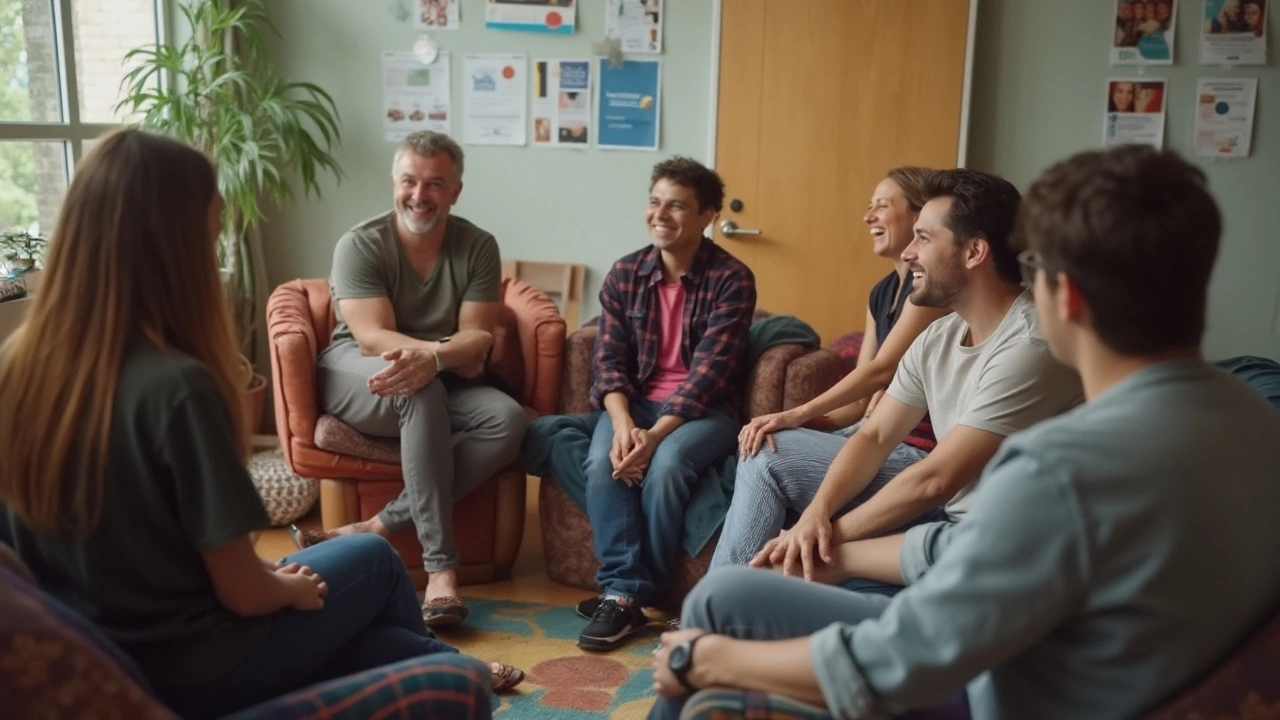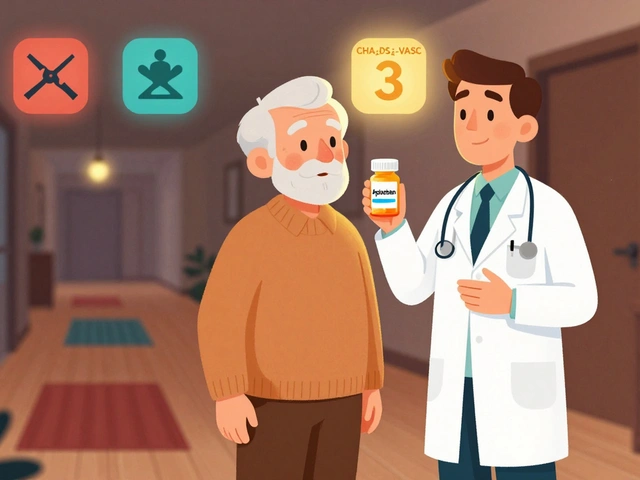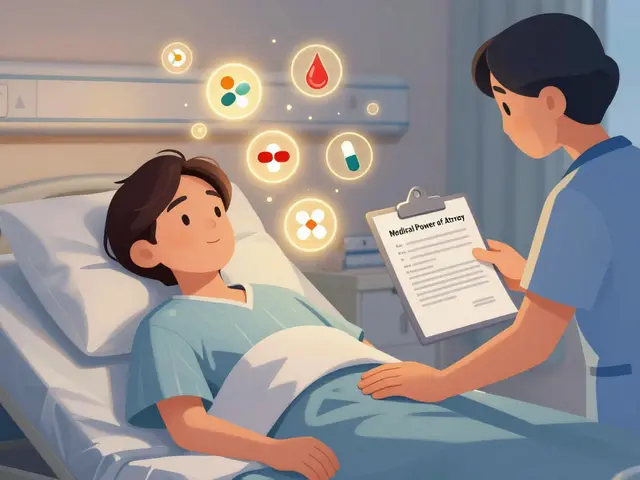
Kaposi Sarcoma is a type of cancer that many have heard about but few fully understand. Stemming from the cells lining the blood and lymph vessels, it creates tumors appearing as purple, red, or brown skin lesions. These can cause discomfort and lead to severe health issues if left untreated.
This article dives into the historical background, recognizing it is often seen in people with weakened immune systems, especially within the LGBTQ+ community. The aim is to increase awareness, share the available treatment options, and offer resources for prevention and support.
- Introduction to Kaposi Sarcoma
- Historical Context
- How It Affects the LGBTQ+ Community
- Symptoms and Diagnosis
- Treatment Options
- Prevention and Support Resources
Introduction to Kaposi Sarcoma
Kaposi Sarcoma, often abbreviated as KS, is a type of cancer that begins in the cells lining blood or lymph vessels. First described by Moritz Kaposi in 1872, it is named after this Hungarian dermatologist who initially identified it. The disease manifests in multiple forms, categorized based on the population it affects and the disease's progression.
Classically, KS was mainly seen in older men of Mediterranean and Eastern European descent. These initial cases were relatively indolent, with slow progression and rare occurrence outside its primary demographic. However, the scope and impact of the disease have shifted dramatically over time. Today, KS holds significant relevance in populations with compromised immune systems, especially among those living with HIV.
One of the reasons Kaposi Sarcoma remains a critical area of concern within the LGBTQ+ health community is its strong connection to HIV/AIDS. With the onset of the HIV epidemic in the 1980s, KS soared as one of the most visible and alarming complications of AIDS. Before effective HIV treatment became prevalent, nearly half of HIV-infected individuals developed KS. With better access to antiretroviral therapy, incidents dropped, but KS still remains an issue, particularly for those with late-diagnosed or untreated HIV.
According to the National Cancer Institute, Kaposi Sarcoma originates from the infection of cells by the human herpesvirus-8 (HHV-8), also known as Kaposi Sarcoma-associated herpesvirus (KSHV). While most people infected with HHV-8 do not develop KS, those with weakened immune systems, such as HIV-infected individuals, are at higher risk. This link underscores the disease's status as an 'AIDS-defining cancer,' a poignant reminder of the interplay between viral infections and the development of certain cancers.
Dr. Alexandra Levine, an expert in hematologic malignancies, once stated, "Understanding the relationship between HHV-8 and the immune system's integrity offers crucial insights into the management and prevention of Kaposi Sarcoma. Continuous research is necessary to further improve outcomes for affected individuals."
KS's manifestations are distinctive and often lead to its diagnosis. Skin lesions, appearing as purple, red, or brown blotches, can emerge anywhere on the body. They are not just superficial; lesions can develop internally, affecting organ function and leading to serious complications. Diagnosing KS often requires a biopsy, with subsequent imaging tests to determine the extent of the disease's spread.
Due to its visible and often disfiguring nature, Kaposi Sarcoma can significantly impact the quality of life and mental health of affected individuals. The social stigma associated with the visible symptoms makes raising awareness and fostering understanding crucial. Treatment options available today, including antiretroviral therapy for HIV-positive individuals and specific cancer therapies, have offered hope and improved quality of life for many.
Historical Context
Kaposi Sarcoma was first identified by Moritz Kaposi, a Hungarian dermatologist, back in 1872. It was initially recognized as a rare form of skin cancer that primarily affected older men of Mediterranean or Eastern European descent. At that time, the condition was considered relatively benign and slow-growing, often manifesting as dark spots on the skin. However, the scenario took a drastic turn in the early 1980s.
With the emergence of the HIV/AIDS epidemic, Kaposi Sarcoma found itself in the spotlight again. Doctors began to notice aggressive forms of this cancer on young gay men, marking the first clear link between immunocompromised individuals and the prevalence of the disease. The LGBTQ+ community was significantly impacted, as Kaposi Sarcoma became one of the defining illnesses associated with AIDS. It was during this period that the medical community began to understand the correlation between weakened immune systems and the aggressive nature of the disease.
According to the Centers for Disease Control and Prevention (CDC), early studies highlighted that approximately 50% of individuals with AIDS would develop Kaposi Sarcoma. This alarming statistic fueled urgent research and funding into both AIDS and Kaposi Sarcoma treatments. During this time, medical advancements began to unfold rapidly. Antiretroviral therapies, which aimed at controlling HIV, inadvertently contributed to a decline in Kaposi Sarcoma cases. This marked a turning point in the management of AIDS-related complications, providing a glimmer of hope for affected individuals.
By the mid-1990s, with the introduction of Highly Active Antiretroviral Therapy (HAART), cases began to decline even more rapidly. Given that HAART effectively reduced the levels of HIV in the body, it also helped in bolstering the immune system, making it less susceptible to opportunistic infections like Kaposi Sarcoma. This period also saw a surge in educational campaigns aimed at raising awareness about HIV and preventing its transmission, benefitting the LGBTQ+ community immensely.
"The progress made in treating Kaposi Sarcoma and controlling HIV is a testament to the resilience and activism within the LGBTQ+ community. Their fight gave birth to remarkable medical advancements," stated Dr. Anthony Fauci, a leading immunologist.While the incidence of Kaposi Sarcoma has decreased in countries with advanced healthcare systems, it remains a significant concern in regions where access to these treatments is limited. Sub-Saharan Africa, for instance, continues to report higher cases, exacerbated by limited healthcare infrastructure and high HIV prevalence. The World Health Organization has emphasized the need for global efforts to ensure treatment accessibility and fight the stigma associated with both AIDS and Kaposi Sarcoma.

How It Affects the LGBTQ+ Community
The impact of Kaposi Sarcoma on the LGBTQ+ community is both profound and complex. This cancer was first identified in older men of Mediterranean and Eastern European descent, but it became a major health concern for the LGBTQ+ community during the AIDS epidemic in the 1980s. Today, it remains one of the most visible signs of HIV/AIDS, disproportionately affecting those with weakened immune systems.
The higher prevalence of HIV/AIDS in the LGBTQ+ community, especially among gay and bisexual men, increases the risk of developing Kaposi Sarcoma. This is primarily because HIV, the virus that causes AIDS, severely weakens the immune system, making it easier for diseases like Kaposi Sarcoma to take hold. According to the Centers for Disease Control and Prevention (CDC), while advancements in HIV treatment have reduced the occurrence of Kaposi Sarcoma, it still poses a significant threat.
Another layer to this issue is the social stigma and discrimination faced by LGBTQ+ individuals. These challenges can discourage people from seeking medical help or discussing symptoms, leading to delayed diagnosis and treatment. This hesitation amplifies the health risks, as early detection of Kaposi Sarcoma is crucial for effective management and better outcomes. The intersection of these medical and social factors makes understanding and addressing the disease as it pertains to the LGBTQ+ community even more important.
A famous quote from the American Cancer Society encapsulates the urgency of timely healthcare:
"Early detection and treatment are key to improving outcomes for those diagnosed with Kaposi Sarcoma, particularly within vulnerable communities."The importance of education and awareness cannot be stressed enough. The more informed individuals are about their health risks and symptoms, the more proactive they can be in seeking medical care.
It's also important to address the psychological toll Kaposi Sarcoma can take on LGBTQ+ individuals. The visible lesions on the skin are not just a physical symptom but also a source of anxiety and social distress. This can lead to mental health issues like depression and anxiety, which in turn can affect overall quality of life. Comprehensive care that includes mental health support is essential for those affected.
Community support networks play a crucial role in combating these challenges. Organizations dedicated to LGBTQ+ health, such as The Trevor Project and GLAAD, provide resources and emotional support for individuals dealing with Kaposi Sarcoma and other health issues. These organizations offer a safe space for sharing experiences, obtaining information, and accessing medical care. Support groups, both online and offline, offer a sense of belonging and reduce the isolation many feel when grappling with health problems.
In summary, the increased risk of Kaposi Sarcoma within the LGBTQ+ community underscores the need for awareness, early detection, and comprehensive care. By addressing both the medical and social aspects of the disease, it is possible to improve the health and well-being of those affected. Ensuring access to healthcare and fostering a supportive community environment are crucial steps in this ongoing battle.
Symptoms and Diagnosis
Identifying Kaposi Sarcoma can be challenging, given that its symptoms often resemble those of other conditions. Early signs primarily manifest as discolored patches on the skin, which could be mistaken for bruises or harmless skin conditions. These lesions usually appear on the legs, feet, or face but can also be found in the mouth, respiratory tract, and lymph nodes. This makes it crucial to seek medical advice if unusual skin changes occur, especially for individuals with compromised immune systems.
While these skin lesions are the most visible indicators, Kaposi Sarcoma can affect internal organs too. This can lead to symptoms such as shortness of breath, chest pain, or gastrointestinal issues like nausea, vomiting, and abdominal pain. When these symptoms accompany skin lesions, it is particularly important for health professionals to consider Kaposi Sarcoma as a potential diagnosis.
Diagnosing this condition involves a combination of physical examinations and laboratory tests. A biopsy of the lesion is often the first step, where a sample of the affected tissue is examined under a microscope for cancer cells. Imaging tests like X-rays, CT scans, and endoscopies might follow to determine if the internal organs are involved. Blood tests are also utilized to check for co-infections such as HIV, which frequently accompanies Kaposi Sarcoma, further complicating the individual’s health.
Expert Opinions
According to Dr. Judith Currier, a professor of medicine at UCLA, “Early detection and treatment of Kaposi Sarcoma are vital as this cancer can rapidly progress in immunocompromised individuals. Comprehensive care often leads to better outcomes.”
Understanding the correlation between a weakened immune system and the onset of Kaposi Sarcoma highlights why LGBTQ+ community members with HIV/AIDS are at a higher risk. Routine monitoring for unusual symptoms is advised, particularly for those with a history of opportunistic infections. Awareness and timely medical intervention can significantly manage the disease's progression.
Public health initiatives emphasize the importance of reducing stigma around HIV/AIDS to encourage earlier testing and treatment. This strategy is crucial as early identification can lead to more effective management of both HIV and Kaposi Sarcoma, improving the patient’s quality of life.
| Symptom | Frequency |
|---|---|
| Skin Lesions | 90% |
| Shortness of Breath | 60% |
| Gastrointestinal Issues | 50% |
In summary, recognizing the symptoms of Kaposi Sarcoma early on and seeking medical advice promptly is crucial for effective management. Regular health check-ups and maintaining an open dialogue with healthcare providers can lead to better outcomes, particularly for those in the LGBTQ+ community.

Treatment Options
Treating Kaposi Sarcoma can be quite complex due to the nature of the disease and its impact on the body. Doctors consider several factors, including the patient’s overall health, immune system status, and extent of the cancer. There are a variety of treatment options available, each with its own benefits and challenges. The primary goal is to control the symptoms, reduce tumor size, and improve quality of life.
One of the main treatments for Kaposi Sarcoma is radiation therapy. This involves using high-energy rays to target and destroy cancer cells. Radiation can be particularly effective for lesions that are localized and causing significant symptoms, like pain or bleeding.
In cases where the disease is more widespread or where radiation isn't suitable, chemotherapy might be an option. Chemotherapy drugs circulate throughout the body and target rapidly dividing cancer cells. These treatments can be taken orally or administered intravenously. A frequent combination of drugs used for this purpose includes liposomal doxorubicin and paclitaxel.
For patients with HIV, antiretroviral therapy (ART) is a crucial part of the treatment plan. ART helps to boost the immune system by reducing the viral load, making it easier for the body to fight off cancer and other infections. Studies have shown that effective ART can lead to a significant reduction in Kaposi Sarcoma lesions.
According to Dr. Jerome Groopman, a leading AIDS researcher, "ART has revolutionized the management of Kaposi Sarcoma in HIV-positive patients. It's not just about controlling the virus but also about improving overall immunity, which can have a remarkable impact on the progression of the disease."
Another approach is immunotherapy, which leverages the body's immune system to combat cancer. This treatment involves using substances made by the body or in a lab to improve or restore immune system function. Interferon-alpha is a type of immunotherapy that has been used to treat Kaposi Sarcoma, particularly in patients whose disease hasn't responded to other treatments.
In some situations, doctors might recommend surgery to remove large or painful lesions. Surgical options include excision, where the lesion is cut out, and curettage and electrodesiccation, which involves scraping away the tumor and using electric current to kill any remaining cancer cells. However, surgery isn't always suitable, especially with multiple lesions.
It's also important to consider supportive therapies that can help manage symptoms and improve overall well-being. These might include pain management, nutritional support, and counseling services. Patients often benefit from a holistic approach that addresses the physical, emotional, and social aspects of their illness.
For individuals in the LGBTQ+ community, finding a supportive healthcare team that understands the specific challenges can make a substantial difference. Organizations like the National LGBT Cancer Network provide resources and support to ensure that all patients receive compassionate and comprehensive care.
Prevention and Support Resources
Preventing Kaposi Sarcoma, especially within the LGBTQ+ community, requires a multifaceted approach. Because this cancer is often linked to a weakened immune system, one important strategy involves maintaining a robust immune system. This can be achieved through regular medical check-ups and adhering to prescribed treatments for any underlying conditions, such as HIV.
It’s crucial for individuals in the LGBTQ+ community to have access to comprehensive and inclusive healthcare. Regular screening for signs of Kaposi Sarcoma should be part of routine health assessments, especially for those with HIV. Early detection can significantly improve treatment outcomes. Establishing a good relationship with healthcare providers who understand the specific health needs of the LGBTQ+ population is also vital for effective prevention.
Education plays a significant role in prevention. Understanding the risks and symptoms of Kaposi Sarcoma can help individuals take proactive steps. Community health organizations, particularly those focusing on LGBTQ+ health, often provide valuable information and resources. Participating in workshops, health fairs, and peer support groups can enhance awareness and encourage community members to prioritize their health.
According to Dr. Anthony Fauci, a leading expert in infectious diseases, "The key to managing Kaposi Sarcoma, especially in immunocompromised populations, lies in early detection and sustained medical interventions."
Support resources are equally important, offering emotional and psychological assistance to those affected. Support groups, both online and offline, provide spaces for sharing experiences and advice. They also help reduce the feeling of isolation that can accompany a cancer diagnosis. Mental health services are crucial, as the emotional burden of dealing with a chronic illness can be overwhelming.
Access to treatment and medication is another critical aspect. Many cancer treatment centers and hospitals offer specialized programs for LGBTQ+ patients, ensuring that they receive tailored care. Financial aid programs can also help alleviate the burden of medical expenses. Certain non-profits and community organizations may provide financial support or connect individuals with resources that can help fund their treatment.
| Resource | Type |
|---|---|
| AIDS Healthcare Foundation | Healthcare Services |
| The Trevor Project | Mental Health Services |
| Human Rights Campaign | Advocacy & Support |
Engaging with advocacy groups is also beneficial. Organizations such as the Human Rights Campaign work tirelessly to ensure the rights and well-being of LGBTQ+ individuals are protected, including access to adequate healthcare. Being part of a larger movement provides support on a broader scale and fosters a sense of solidarity.
Preventing Kaposi Sarcoma isn't just about medical care; it's about creating a supportive and informed community. By taking advantage of the available prevention measures and resources, individuals can better protect their health and support others in doing the same. It is a collective effort, involving healthcare providers, community organizations, and the individuals themselves. Together, these changes can lead to better health outcomes and a more resilient community.






20 Comments
Wow, another deep dive into a topic nobody asked for.
They hide the real cure for Kaposi in plain sight while pushing pills that keep us dependent. The pharma lobby exploits the HIV community, and the media pretends they care. Meanwhile, the cure is out there, suppressed by the powers that be. It's all a grand experiment, and we’re the guinea pigs.
From a pathophysiological standpoint, KS illustrates oncogenic viral latency coupled with immunosuppression, yielding endothelial proliferative lesions. The interplay of HHV‑8 oncogenes and diminished CD4+ counts precipitates neoplastic angiogenesis.
Great info! 🌈❤️ Stay hopeful and keep getting those check‑ups.
For anyone dealing with KS, the first step is to ensure optimal antiretroviral therapy. ART not only suppresses HIV viral load but also restores immune competence, which can lead to regression of KS lesions. If lesions persist, local therapies such as radiation or intralesional chemotherapy are effective. Systemic therapy, like liposomal anthracyclines, is reserved for widespread disease. Additionally, regular dermatologic follow‑up is essential to monitor lesion evolution and screen for secondary infections. Nutrition, mental health support, and community resources round out a comprehensive care plan.
Building on that, consider the psychosocial dimension: patients often grapple with stigma, which can impede adherence. Peer‑support groups have shown measurable improvements in ART compliance and quality of life. So, integrating medical and community interventions creates a synergistic effect.
Interesting read, especially the part about how early detection can change outcomes.
Indeed, early screening is vital. In many regions, community health workers are trained to spot early lesions, which helps bridge the gap where specialist access is limited.
KS risk is proportional to CD4 decline.
The article does a solid job summarizing the epidemiology, but it could go deeper into the molecular mechanisms linking HHV‑8 latency to angiogenic pathways. Understanding that connection could guide targeted therapies beyond conventional chemo‑radiation.
👍 Great point! More research on that front would be awesome.
I'm feeling the weight of this information, yet hopeful.
Kaposi Sarcoma serves as a paradigmatic illustration of how virology, immunology, and oncology intersect within a sociocultural context that amplifies its impact on marginalized communities. Historically, the disease emerged as a visible marker of the AIDS epidemic, underscoring the vulnerability of immunocompromised hosts to opportunistic malignancies. The etiologic agent, human herpesvirus‑8 (HHV‑8), establishes latency within endothelial progenitor cells, exploiting viral oncogenes such as v‑cyclin and v‑FLIP to subvert apoptosis and promote angiogenesis. When CD4+ T‑cell counts plummet, the host's surveillance mechanisms falter, allowing unchecked clonal expansion of infected cells. Clinically, lesions manifest as violaceous macules, papules, or nodules, frequently initiating on the lower extremities before disseminating to mucosal sites and visceral organs. Diagnosis hinges on histopathologic confirmation of spindle cell proliferation and immunohistochemical detection of HHV‑8 latent nuclear antigen. Therapeutically, the cornerstone remains robust antiretroviral therapy, which reconstitutes immune function and can precipitate lesion regression. Adjunctive modalities-local radiation, intralesional chemotherapy, systemic liposomal anthracyclines, and emerging immunotherapies-are stratified by disease burden and patient comorbidities. Preventative strategies emphasize routine HIV screening, early ART initiation, and education to mitigate stigma that impedes health‑seeking behavior. Community-based resources, such as LGBTQ+ health networks, furnish psychosocial support essential for navigating chronic illness. Moreover, global health disparities persist; regions with limited ART accessibility report higher KS incidence, highlighting inequities in healthcare infrastructure. Ongoing research into HHV‑8 viral genetics and host immune polymorphisms promises to refine risk stratification and unveil novel therapeutic targets. In sum, Kaposi Sarcoma exemplifies a disease where biomedical insight, public health policy, and social justice converge, demanding a multidisciplinary response that addresses both the virus and the vulnerable populations it afflicts.
The long post is good but kinda over the top. Remember, not everyone wants a PhD thesis in the comments.
For anyone feeling overwhelmed, it helps to break the information into bite‑size pieces. Start with learning the signs, then look into local support groups that specialize in LGBTQ+ health.
While empathy is noble, we must also hold ourselves accountable for seeking timely care. No one can excuse neglect based on shame; the disease doesn’t wait for our moral dilemmas.
Remember, the best defense is a good offense: stay on top of your HIV meds, get regular skin exams, and don’t ignore a new spot. Proactive steps save lives.
Sounds solid. Thanks for the quick rundown!
From a clinical perspective, integrating multidisciplinary care-infectious disease, oncology, dermatology, and mental health-optimizes outcomes. Each specialist contributes a piece of the puzzle, ensuring comprehensive management.
Indeed, a coordinated approach reduces fragmentation of care. Moreover, leveraging tele‑medicine can extend specialist access to underserved regions, narrowing the disparity gap.